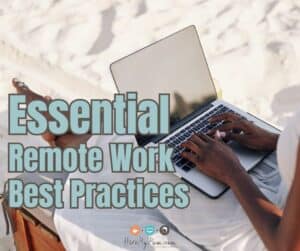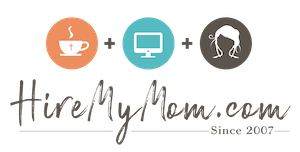Essential Remote Work Best Practices

With the flexibility and convenience it offers, remote work has revolutionized the traditional office setting. However, in order to be successful in a remote work environment, it is essential to follow certain best practices to ensure productivity, communication, cybersecurity, company culture, and work-life balance are maintained.
Setting Up a Productive Home Office Environment
This means creating an area within your home that is specifically reserved for work activities, a step that significantly aids in mentally shifting into work mode. It’s vital to equip this space with ergonomic furniture, such as a desk and chair that support proper posture, thereby minimizing physical strain over long hours of work. Adequate lighting, preferably natural light, enhances focus and reduces eye strain, making it a crucial element of your home office setup. Organizing your workspace to keep it tidy and free from clutter not only helps in reducing distractions but also contributes to a more enjoyable and productive work environment. Ensuring that you have the right technology and connectivity, including a dependable computer, robust internet service, and any job-specific hardware or software, is essential for seamless remote work.
Establishing Clear Communication Channels and Guidelines
Choosing the right communication platforms is critical; tools like Slack for text, Zoom for video calls, and Microsoft Teams for collaborative projects streamline the flow of information. It’s imperative to define clear guidelines on how and when to use each tool to avoid confusion. Regularly scheduled virtual meetings keep the team aligned on goals and progress while providing a forum for addressing concerns and brainstorming. Establishing norms around response times and availability ensures expectations are met and respects individual work patterns. Emphasizing the importance of concise and effective communication can significantly enhance the efficiency and cohesion of a remote team.
Implementing Robust Cybersecurity Measures
Initiating strong cybersecurity protocols is not just about protecting assets but also about preserving trust within remote teams. It begins with the fundamental step of educating team members on the significance of security practices. Regular training sessions on recognizing phishing attempts, secure password creation, and the dangers of public Wi-Fi can empower employees to be the first line of defense against cyber threats.
Advancing further, the deployment of technical safeguards is crucial. Utilizing encrypted connections through Virtual Private Networks (VPNs) ensures that data remains secure during transmission. Implementing end-to-end encryption for emails and files protects information from being intercepted or misused. Additionally, the use of multi-factor authentication (MFA) adds an extra layer of security, making it significantly harder for unauthorized individuals to gain access to critical systems.
For small business owners, the investment in robust cybersecurity software is indispensable. This includes antivirus and anti-malware solutions, alongside firewalls that monitor and control incoming and outgoing network traffic based on predetermined security rules. Regular updates and patches for all software are essential to protect against newly discovered vulnerabilities.
Finally, creating a comprehensive incident response plan prepares remote teams to act swiftly and efficiently should a security breach occur. This plan should outline specific steps for containment, eradication, and recovery, ensuring minimal impact on business operations and maintaining client trust. Through these collective efforts, remote work environments can achieve a high standard of cybersecurity, allowing teams to focus on productivity and innovation without the looming threat of cyber attacks.
Fostering a Strong Company Culture Remotely
Creating a cohesive company culture when working remotely requires thoughtful strategies to ensure every team member feels valued and connected. Organizing interactive online activities such as team-building exercises, virtual coffee breaks, or themed video meetings can bridge the physical gap and promote a sense of belonging. Recognizing individual and team accomplishments publicly through online platforms not only boosts morale but also reinforces a culture of appreciation and respect.
Implementing regular check-ins and feedback sessions can provide employees with a platform to voice their ideas and concerns, strengthening the bonds within the team. Additionally, encouraging informal communication through dedicated chat rooms for non-work-related conversations allows personalities to shine and relationships to deepen. By integrating these practices, small business owners can cultivate a vibrant and supportive remote work environment where creativity and collaboration flourish, ensuring that every member feels an integral part of the team despite the geographical distances.
Encouraging Work-Life Balance for Remote Employees
Implement defined work hours; this creates a clear demarcation between professional responsibilities and personal time. Encouraging the adoption of this schedule helps remote employees resist the urge to overwork, fostering a healthier lifestyle and enhancing productivity. Encouraging frequent breaks throughout the day is another essential practice. These pauses from work are vital for mental and physical rejuvenation, allowing employees to return to their tasks with renewed focus and energy.
Promoting physical activity and mindfulness exercises can also significantly contribute to an improved work-life balance. Engaging in regular exercise or mindfulness activities such as yoga or meditation can mitigate stress, boost morale, and improve overall mental health. Additionally, advocating for a specific, distraction-free workspace aids in minimizing interruptions, allowing for more concentrated work periods which in turn support a more structured day.
Lastly, it’s important for employers to lead by example. Demonstrating a commitment to maintaining one’s own work-life balance sets a positive precedent for the team. Offering support for employees to prioritize their personal time, including unplugging after work hours, highlights the value placed on their well-being. By incorporating these practices, small business owners can help ensure their remote teams remain productive, motivated, and well-balanced.
What are some of the practices you and your remote team have in place to create a well-functioning and balanced virtual workspace?
